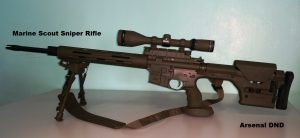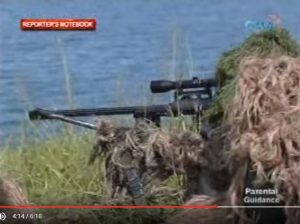
Philippine Defense Today (Adroth.ph)
In Defense of the Republic of the PhilippinesWhy 5.56mm sniping rifles for the AFP?
Saturday , 10, September 2016 Army, Philippine Army, Philippine Navy Leave a commentOn August 21, 2006 the Timawa forum saw a discussion between a Philippine Marine Colonel (MBLT6) and a Singaporean Army Major (Shingen) about sniper rifles an engagement distances in the the Philippine setting. The end result was a glowing response from Shingen as follows:
This is one of the best post, or not the best post i have seen so far in this forum. Thank you so much for clarifiying things, all your examples are very clear and informative, especially no. 3. Would add this to my scrapbook and use it as material if required back camp.
This accolade elevated this discussion to a “reference thread” which moderators took special care in keeping troll free.
 |
 |
|
| Marine Scout Sniper Rifle (5.56mm) | Barret (12.7mm / .50 cal) |
In an effort to preserve this discussion from database crashes and similar incidents, this section the following thread has been replicated here:
First, lets define terms. The term primary sniper rifle refers to primary range. Our (Marine Corps) doctrine requires three types of sniper rifles ie., primary range (max 600m for company level) , intermediate range ( 800m max and a Bn organic) and long range (1000m and a Brigade organic). We practice combined arms concepts which means higher units may attach thier organic units to subordinates in order to tailor fit their capabilities to the environment they are operating in and the threats they are facing. secondly, the term sniper rifle does not dictate on the caliber. Its defined as a rifle with a scope accurized with high quality parts (match grade) and uses match grade ammunition. The 5.56mm round in the MSSR qualifies per our doctrines and international definition.
Why have 3 types of sniper rifles? Based on our experience in battling communist, muslim seperatist and military adventurism for 30+ years in different terrains in the Philippines. We had learned that under different sniping conditions the characteristics of a type of sniper rifle has its pros and cons.
Example 1. a sniper stalks his prey that requires moving at the least observation by the enemy the reason he has to be a master of camoflauge to avoid detection. It will be diffucult to crawl with a cal 50 barret. The MSSR will be a favorite in this conditions.
Example 2: The MSSR or primary range rifle is the king of 600m engagements simply due to lesser recoil. It accounted most of the kills in our year 2000 campaign in central mindanao. Why? against multiple targets and follow through shot in case of a miss nothing beats the 5.56mm round. the lesser recoil ensures target acquisition after recoil. We tested this with the equally accurisided M-21 7.62mm. each equally skilled sniper were required to shoot 6 poppers each and armed with the M21 and MSSR at 400m. The MSSR finished his 6th popper while the other was just starting to aim for his 3rd – FOV issues due to recoil i’m sure you know. Example 3: the cal 50 barret has the needed characteristics for longer range simply because of of its heavier 750 grain bullet which is less prone to that devil wind that all snipers fear. The MSSR cannot compete with this at longer range. But at shorter ranges below 600m the barret has distinct disadvantages. It has a louder sound report, flash and concussion (leaves/bushes moves) allowing easier detection and wow expect counter fire from the enemy. A sniper always ensures he is not detected please don’t do this in engaging the enemy with highly trained countersnipers. The barret is best in engagements at 1000m+ in a jungle environment if you can find one. the rule is more max at 400m. The MSSR has a an almost negligble flash an sound report. The 24 inch barrel has its advantages it ensures the total burning of the propellant before the bullet exits the muzzle hence lesser flash as well as higher velocity means lesser leads in moving targets – the 5.56mm round does have at least 250+ fps higher speed the the 7.62mm and cla 50 round – right?. longer barrels adds more velocity and having more range and lethality. and of course lesser concussion and sound report compared to the 7.62 and cal.50 round. the MSSR was adopted by us in 1996 and copied by the IDF and US in 2000 you are more than welcome to learn from our experiences.
I really had the same perceptions in my youth when I was a Lt 24 yrs ago. The macho 7.62mm or even the cal 30 (7.62mm x 54) M-1 garand round were superior in all aspects. But my experience change that with advancements in weapons technology as well as my combat and competition experience. I was amazed with the results of our 2000 year campaign as well as the success of the M-16 in the Service Rifle Competitions in Camp Perry,Ohio which since 1996 it had dominated the championships beating the favorites as the M-1A1 and military versions M-14 rifles. We in the Marine Corps have the only existing sniper school in the Philippines since 1967. We load our own match ammo for 5.56mm and 7.62mm in 69 grain Sierra BTHP match, 75 grain Hornady and 168 grain Sierra in 7.62mm BTHP match as well as subsonic rounds for both calibers for use in our Night Fighting Weapon System. Don’t know if there are existing sniper schools in other in southeast asian countries. And please no more lethality issues – shot placement at 600m is not an issue for the MSSR our snipers are trained to hit head shots at 600m and even a cal .22LR at shorter distances can ensure that kill. I’ve seen that – we operate in the most volatile region in Southeast Asia.